 |
How to Use the Search Screen
- Place names may include names and appellations for nations, inhabited places (e.g. cities and villages), and physical features (e.g. mountains and rivers). Current and historical names may be included. The TGN is not comprehensive. It grows over time through contributions. The focus of the TGN is on places important for art, architecture, and related disciplines.
Queries Using Find Name
- To find names in the TGN, type one or more words in the Find Name field, using the guidelines described below. To learn more about what kinds of names are included in the TGN, see About the TGN: Information in the Record (Fields).
- Case and punctuation: Names may be entered in upper or lower case, with or without spaces and punctuation.
 |
|
|
 |
Examples: |
|
 |
Find Name: |
Los Angeles |
 |
Find Name: |
LOS ANGELES |
 |
Find Name: |
losangeles |
 |
|
- Diacritics: Names may be entered with or without diacritics (in the example below, querying with the umlaut will retrieve the same results as typing the "a" without the umlaut).
 |
|
|
 |
Examples: |
|
 |
Find Name: |
Allgäu |
 |
Find Name: |
Allgau |
 |
|
- Boolean operators: You may use AND or OR in the Find Name field. These Boolean operators must be in ALL CAPS.
 |
|
|
 |
Examples: |
|
 |
Find Name: |
Cerro AND Angeles |
 |
Find Name: |
Marakesh OR Marrakech |
 |
|
- Parentheses: You may use parentheses with AND and OR. When using both AND and OR in the same query, parentheses should be used in order to retrieve meaningful results.
 |
|
|
 |
Examples: |
|
 |
Find Name: |
(St OR Saint) AND Louis |
 |
Find Name: |
(el OR al) AND (Amarnah OR Amarna) |
 |
|
- Wildcard: You may use the asterisk (*) as a wildcard for right-hand truncation. You may also use a wildcard in the middle of the name. Left-hand truncation (leading truncation) is not allowed. You may use AND or OR with wildcards. Truncation of words with only a few letters (e.g., Al*) will generally produce too many results and you will be prompted to narrow your search.
 |
|
|
 |
Examples: |
|
 |
Find Name: |
Machu Pic* |
 |
Find Name: |
Frankf*rt |
 |
Find Name: |
Alexand* OR Alessand* |
 |
|
- Quotes: You may use quotes to find an exact match on your phrase. When you do not use quotes, the search engine looks for individual keywords that match your query. Using quotes is a good way to limit your search when the name is also a keyword in many multiple-word names (e.g., the example below will retrieve a concise list of only places called simply "Paris," not place names with other keywords, such as "Conflans-lès-Paris" or "New Paris").
 |
|
|
 |
Example: |
|
 |
Find Name: |
"Paris" |
 |
|
- Quotes with Booleans: You may use quoted phrases with OR; however, you may not use quoted phrases in parentheses. Note that quoted phrases would produce zero results with AND because such a query would be illogical. You may combine quoted and unquoted phrases.
 |
|
|
 |
Examples: |
|
 |
Find Name: |
"York" OR "New York" |
 |
Find Name: |
Hole in the Wall OR "Tombstone" |
 |
|
- Stemming: Stemming may be enabled by placing a dollar sign ($) in front of the keyword that you wish to retrieve. Stemming allows queries for the word and its morphological variants. For example, $hold would retrieve all names that contain the word hold or its grammatical variants in English: holds, held, holding. Stemming is a feature designed to work best with English words; it is only occasionally useful with place names. You may use stemming with AND and OR. You may use stemming with parentheses. Stemming would produce zero results when used with quotes because such a query would be illogical. Stemming of common words in names, such as Lake or Mill, will probably produce too many results and you will be prompted to narrow your search.
 |
|
|
 |
Examples: |
|
 |
Find Name: |
$Shock |
 |
Find Name: |
$Hold AND (Tank OR Creek) |
 |
|
Queries Using Place Type:
- When using Find Name, you may narrow your query (i.e., reduce the number of results) by also listing a Place Type, which is a word or phrase that describes the role or characteristic of the place (e.g., nation, archaeological site, monastery, peak). To learn more about place types in the TGN, see About the TGN: Information in the Record (Fields).
- You may not use AND, OR, or wildcards in the Place Type field. You may search for multiple place types by placing a comma between place types.
- Using the Place Type field without Find Name will typically result in the retrieval of too many places and you will be prompted to narrow your query.
- You may see a list of valid values for place types by clicking on Lookup. In the Lookup window, note that you may check multiple boxes to perform a search on multiple place types in the same query.
Queries Using Nation:
- When using Find Name, you may narrow your query (i.e., reduce the number of results) by also listing a Nation. You may use all three fields, Find Name, Place Type, and Nation together to narrow a query.
- You may not use AND, OR, or wildcards in the Nation field. You may search for multiple nationalities by placing a comma between nationalities.
- Using the Nation field without Find Name will generally result in the retrieval of too many places and you will be prompted to narrow your query. If you do not use Find Name, queries using both Place Type and Nation together are more likely to produce a reasonable number of results than using either one alone; however, such queries may also produce too many results if the place type is common and the nation is large (e.g., a search for inhabited places in the United States would not succeed). In the example below, the place type and nation together bring back a manageable number of results.
- You may see a list of valid values for Nations by clicking on Lookup. The Lookup list includes nations, dependent states, and continents. In the Lookup window, note that you may check multiple boxes to perform a search on multiple nations in the same query.
Searching Tips
- If you are unsure of the spelling of a name, you may use the wildcard (e.g. Vindob*). Only right and middle truncation are supported; left truncation is not allowed.
- If you fail to retrieve the place you are looking for, try looking for a single keyword, or two keywords with Boolean operators. For example, if a search for Big Baldy Mountain does not return the mountain you are looking for, try looking for Big AND Baldy. This method is particularly useful when querying for physical features (e.g., rivers, mountains, etc.) and administrative entities (e.g., states, counties, etc.), because the generic descriptive parts of such names (e.g., Mountain or Province) are often omitted in the name itself.
- If the name you seek has a character with a diacritical mark and your search was unsuccessful, try typing the character without the diacritic.
- If you have searched for a name in inverted order and your search was unsuccessful, try searching for the name in natural order (e.g., search for Al-Hoceima rather than Hoceima, Al-).
- There is no stop list in The TGN Online. For example, since the words and and the are not on a stop list, you may search for names such as The Hague and Antigua and Barbuda.
- If you wish to use Boolean operators, you must capitalize the AND or OR.
- There is a limit of 5000 results. If you retrieve too many records, narrow your search by 1) including more of the name (include more letters of the name or a second keyword of the name), 2) adding the nation as a criterion, or/and 3) adding the place type as a criterion.
- When you cannot find a record by querying, try browsing through the hierarchy. Either click Browse the TGN Hierarchies below the search box, or search for a broader context. For example, if you are looking for a place in Siena province, Italy, you can search for Siena province, click on the hierarchy for Siena province, and look at all the places in this section of the hierarchy.
How to Read the Search Results
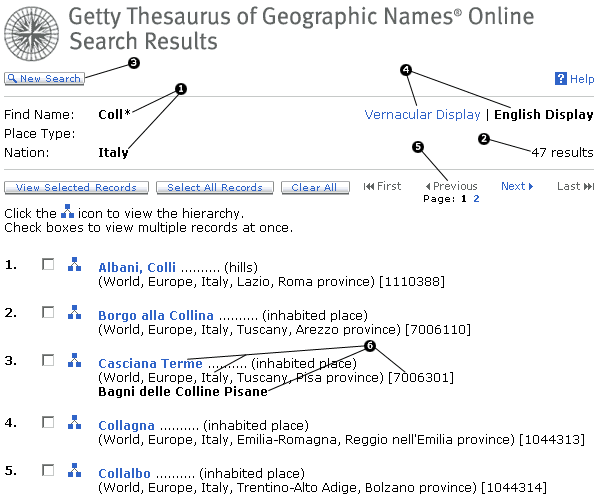
 |
 |
|
 |
 |
At the upper left of the Search Results, you will see the criteria that were used to retrieve the results (e.g., in the example above, Find Name was Coll* and Nation was Italy). |
 |
 |
|
 |
 |
At the upper right, you will see the total number of results (47 results in the example above). |
 |
 |
|
 |
 |
You may return to the search screen by clicking New Search. |
 |
 |
|
 |
 |
You may switch the display from English to Vernacular. In the English display, the preferred names of places are in English; in the Vernacular display, the preferred names of places are in the vernacular or local name of the place. The phrase displayed in black indicates the current view of the page (English, in the example above). |
 |
 |
|
 |
 |
Use the scroll bar along the right side to see results further down the page. Near the upper right of the page, you will see an indication of the number of pages of results (two pages in the example above) and navigation indicators to go forward or backward through the pages. In the example above, you could click on the number 2 or click Next to go to page two. You could click on First or Last to go to the beginning or end of the set of pages, which is useful when many pages are returned. |
 |
 |
|
 |
 |
Each place is represented in the results list by its preferred name (in Vernacular or English, depending upon how the language is set; see #4 above) and place type. The preferred name is highlighted (in blue). On the line below the name is the parent string for the place, listing broader contexts in descending order. The number in square brackets is the unique numeric identifier (Subject ID) for the place in the TGN database. All names that matched the query are in the results list. If a name that matched the query is not the preferred name, it will be listed under the parent string, in black letters. For example, in result number 3 above, the preferred name for the place is Casciana Terme, which did not match the query. A variant name, Bagni delle Colline Pisane, matched the query (it has a keyword that matches Coll*) and is displayed in black. |
 |
 |
|
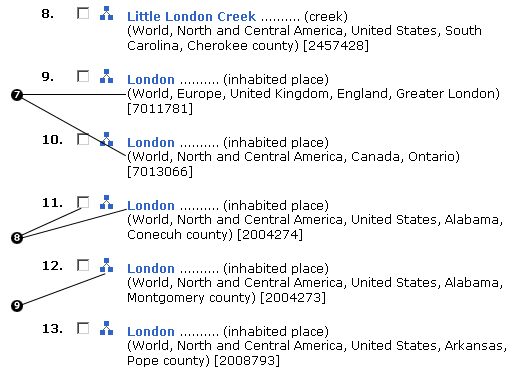 |
 |
 |
|
 |
 |
The results are arranged in alphabetical order. Homographs are sorted by the parent string (e.g., in the above example, the parents World, Europe ... alphabetize above World, North and Central ...). |
 |
 |
|
 |
 |
You may view the Full Record Display for any of the results by clicking on the highlighted (blue) preferred name. You may view multiple records at once by checking the boxes at the left and clicking View Checked Records at the top of the screen. You may clear checks from the boxes by clicking Clear All at the top of the screen. |
 |
 |
|
 |
 |
You may go to the hierarchy for any of the records in the results list by clicking on the hierarchy icon to the left of the name. |
 |
 |
|
How to Read the Full Record Display
- To go to a full record for a TGN place, you must be in a results list or the hierarchical display. From either display, select the place by 1) clicking on the highlighted (blue) name or 2) checking the checkboxes (to the left of the names) for one or more places and then clicking View Checked Records.
- Brief descriptions of information in a TGN record appear below. A minimum record has a Name, Subject ID, Record Type, Place Type, and Hierarchical Position. For a more complete explanation of the data in a TGN record, see About the TGN: Information in the Record (Fields).
- Subject ID: Unique numeric identification for the TGN record.
- Record Type: Type designation that characterizes the TGN record (administrative, political, guide term, etc.); you may click on the highlighted word(s) to see the definition of the terminology.
- Label: Brief text identification of the place, comprising the preferred name and place type (in parentheses). Click on the hierarchy icon to go to the hierarchy.
- Coordinates: Geographic coordinates indicating the position of the place, expressed in degrees/minutes and decimal fractions of degrees. Latitude (Lat.) is the angular distance north or south of the equator, measured along a meridian. Longitude (Long.) is the angular distance east or west of the Prime Meridian at Greenwich, England. Bounding coordinates and elevation may also be included (as in the example for Great Lakes Region below).
- Note: The Descriptive Note is a note that describes the history or physical location of the place, particularly regarding the importance of the place relative to art and architecture.
- Names: Names and appellations referring to the place, including a preferred name and variant names. Names are displayed with various flags (e.g., "C,V,N" in the example below; click on the flag to see its meaning). The languages for the names may also be included. A "P" following the language indicates that this is the preferred name in that language.
- Display Date for the name: A note referring to a date or other information about the name (e.g., used since 13th century in the example above).
- Hierarchical position(s): A display that shows broader contexts or parents of the place. If there are multiple parents, the preferred parent is listed first.
- Display Date for the parent: A note referring to a date or other information about the link between a child and its parent (e.g., sites near Siena date to the Late Etruscan period in the example above). If a link is historical (rather than current), it is marked with an (H).
- Place Types: Words or phrases describing a role or characteristic of the place (e.g., inhabited place, cultural center). Currently relevant place types are flagged with (C), historical place types are flagged with (H).
- Display Date for Place Type: A note referring to a date or other information about the place relative to the place type (e.g., for inhabited place in the above example, a general date of first habitation is implied).
- Related Places: Associative relationships (i.e., non-hierarchical references) to other places in the TGN; each reference comprises a relationship type plus the preferred name, place type, parent string, and subject ID for the related place. The example below illustrates related places for Siena. Click on the highlighted (blue) name of the related place to go to its record.
- Display Date for the related place: A note referring to a date or other information about the relationship between the two places. The example above includes a display date for the related place, Pisa (Ghibelline allies during the 13th and 14th centuries).
- Sources and Contributors: Initials, abbreviations, or acronyms for the contributing projects or institutions (in square brackets), combined with bibliographic sources. Sources and Contributors may be associated with the record in three ways: with the names, with the record as a whole (subject), and with the note (descriptive note). Click on the initials of the contributor or the brief citation of the source to see a fuller description of the contributor or source.
How to Navigate the Hierarchy Display
- You may go to the Hierarchy Display by clicking on the hierarchy icon in a results list or in a full record display. You may also access it by clicking on Browse the TGN Hierarchies from the search screen.
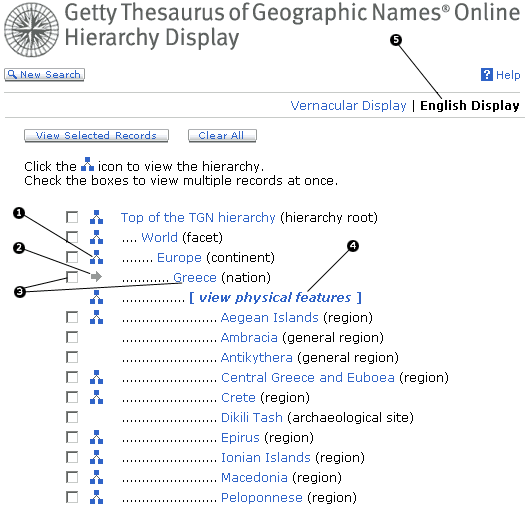
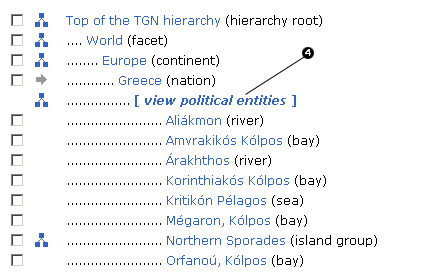
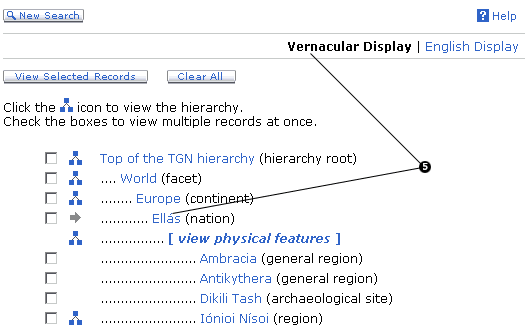
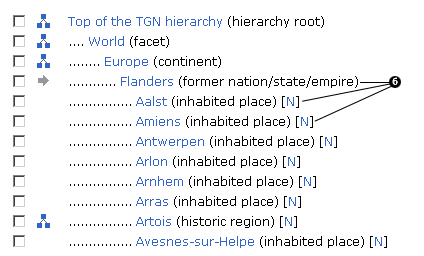
|
 |






